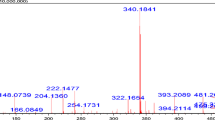Abstract
A mouse monoclonal antibody against abscisic acid (ABA) was produced and characterized. It was raised using ABA conjugated to the carrier protein through the carboxyl (Cl) group as immunogen. It did not discriminate between free ABA or its ester derivatives. This antibody, which is the first monoclonal against Cl-conjugated ABA, shows interesting characteristics. It has high affinity (Ka=1.5 × 109 L/mol) and specificity. Compounds structurally similar to ABA, such as phaseic acid, dihydrophaseic acid, and both the 2,trans-isomer and the (R)-enantiomer of ABA, are not reactive. The narrow linear range of the standard curve (0.018–1.8 pmol) ensures great precision of the assay. This monoclonal antibody has been used for the quantification of ABA conjugates in crude aqueous extracts of bean leaves by radioimmuno-assay (RIA). The fractionation of the extracts by high-performance liquid chromatography (HPLC) confirmed the absence of cross-reacting compounds. Because of its affinity and specificity, in combination with antibodies against free ABA, this antibody should be a sound tool for studying the metabolism and immunolocalization of ABA in plant tissues.
Similar content being viewed by others
References
Daie J, Wyse R (1982) Adaptation of the enzyme-linked immunosorbent assay (ELISA) to the quantitative analysis of abscisic acid. Anal Biochem 119:365–371
Dewdney SJ, McWha JA (1978) The metabolism and transport of abscisic acid during grain fill in wheat. J Exp Bot 29:1299–1308
Harris MJ, Dugger WM (1986) The occurrence of abscisic acid and abscisyl-β-d-glucopyranoside in developing and matureCitrus fruit as determined by enzyme immunoassay. Plant Physiol 82:339–345
Koshimizu K, Inui M, Fukui H, Mitsui T (1968) Isolation of (+)-abscisyl-β-d-glucopyranoside from immature fruit ofLupinus luteus. Agric Biol Chem 32:789–791
Le Page-Degivry MTh, Duval D, Bulard C, Delaage M (1984) A radioimmunoassay for abscisic acid. J Immunol Methods 67:119–128
Leroux B, Maldiney R, Miginiac E, Sossountzov L, Sotta B (1985) Comparative quantitation of abscisic acid in plant extracts by gas-liquid chromatography and an enzyme-linked immunosorbent assay using the avidin-biotin system. Planta 166:524–529
Loveys BR (1979) The influence of light quality on levels of abscisic acid in tomato plants, and evidence for a novel abscisic acid metabolite. Physiol Plant 46:79–84
Loveys BR, van Dijk HM (1988) Improved extraction of abscisic acid from plant tissue. Aust J Plant Physiol 15:421–427
Martin GC, Scott IM, Neill SJ, Horgan R (1982) Identification of abscisic acid glucose ester, indole-3-acetic acid, zeatin and zeatin riboside in receptacles of pear. Phytochemistry 21:1079–1082
Milborrow BV (1970) The metabolism of abscisic acid. J Exp Bot 21:17–29
Milborrow BV (1972) The biosynthesis and degradation of abscisic acid. In: Carr DJ (ed) Plant growth substances 1970. Springer-Verlag, New York, pp 281–290
Milborrow BV (1980) Regulation of abscisic acid metabolism. In: Skoog F (ed) Plant growth substances 1979. Springer-Verlag, New York, pp 262–273
Neill SJ, Horgan R, Heald JK (1983) Determination of the levels of abscisic acid glucose ester in plants. Planta 157:371–375
Ouchterlony O (1958) Diffusion in gel, methods for immunological analysis. In: Kallos P (ed) Progress in allergy 5. Karger, Basel, pp 1–78
Pierce M, Raschke K (1981) Synthesis and metabolism of abscisic acid in detached leaves ofPhaseolus vulgaris L. after loss and recovery of turgor. Planta 153:156–165
Quarrie SA, Galfrè G (1985) Use of different hapten-protein conjugates immobilized on nitrocellulose to screen monoclonal antibodies to abscisic acid. Anal Biochem 151:389–399
Quarrie SA, Whitford PN, Appleford NEJ, Wang TL, Cook SK, Henson IE, Loveys BR (1988) A monoclonal antibody for (S)-abscisic acid: its characterization and use in a radio-immunoassay for measuring abscisic acid in crude extracts of cereal and lupin leaves. Planta 173:330–339
Rosher PH, Jones HG, Hedden P (1985) Validation of a radio-immunoassay for (+)-abscisic acid in extracts of apple and sweet-pepper tissue using high-pressure liquid chromatography and combined gas chromatography-mass spectrometry. Planta 165:91–99
Scatchard G (1949) The attraction of proteins for small molecules and ions. Ann NY Acad Sci 51:660–672
Skene DS, Browning G, Jones HG (1987) Model systems for the immunolocalisation ofcis,trans abscisic acid in plant tissues. Planta 172:192–199
Tietz D, Dorffling K, Wohrle D, Erxleben I, Liemann F (1979) Identification by combined gas chromatography-mass spectrometry of phaseic acid and dihydrophaseic acid and characterization of further abscisic acid metabolites in pea seedlings. Planta 147:168–173
Vernieri P, Perata P, Armellini D, Bugnoli M, Presentini R, Lorenzi R, Ceccarelli N, Alpi A, Tognoni F (1989) Solid phase radioimmunoassay for the quantitation of abscisic acid in plant tissues using a new monoclonal antibody. J Plant Physiol 134:441–446
Walton D, Dashek W, Galson E (1979) A radioimmunoassay for abscisic acid. Planta 146:139–145
Weiler EW (1979) Radioimmunoassay for the determination of free and conjugated abscisic acid. Planta 144:255–263
Weiler EW (1980) Radioimmunoassays for the differential and direct analysis of free and conjugated abscisic acid in plant extracts. Planta 148:262–272
Weiler EW (1982) An enzyme-immunoassay forcis-(+)-abscisic acid. Physiol Plant 54:510–514
Zeevaart JAD (1980) Changes in the levels of abscisic acid and its metabolites in excised leaf blades ofXanthium strumarium during and after water stress. Plant Physiol 66:672–678
Zeevaart JAD, Creelman RA (1988) Metabolism and physiology of abscisic acid. Ann Rev Plant Physiol Plant Mol Biol 39:439–473
Author information
Authors and Affiliations
Rights and permissions
About this article
Cite this article
Perata, P., Vernieri, P., Armellini, D. et al. A monoclonal antibody for the detection of conjugated forms of abscisic acid in plant tissues. J Plant Growth Regul 9, 1–6 (1990). https://doi.org/10.1007/BF02041934
Received:
Accepted:
Issue Date:
DOI: https://doi.org/10.1007/BF02041934




